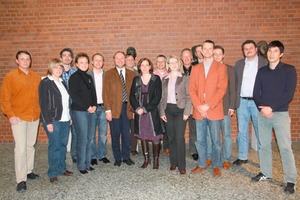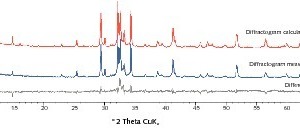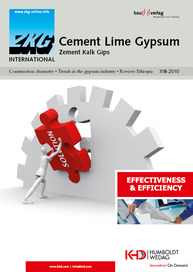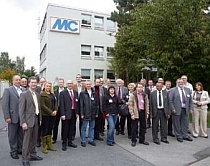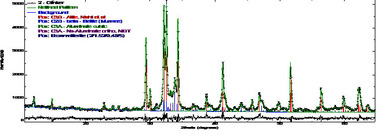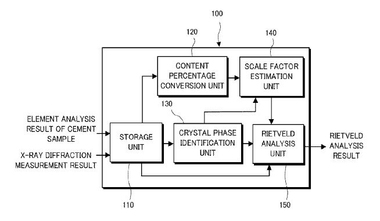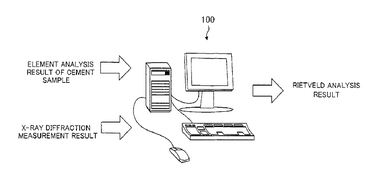Methodical procedure for Rietveld analysis
Second meeting of the “Rietveld Analysis” workgroup, TU Munich/Germany (13.04.2010)In 2009, the specialist Building Chemistry Group of the German Chemical Society (Gesellschaft Deutscher Chemiker, GDCh) set up a “Rietveld Analysis” workgroup (Fig. 1) chaired by Prof. Dr. J. Plank (TU Munich). The aim of this group is the development of a protocol for the methodical procedure in the Rietveld analysis of cements which would make it possible to approach the actual phase content as accurately as possible (Fig. 2). In addition to the familiar procedures for Rietveld analysis, specimen treatment and preparation methods were to be taken into account, as well as the refinement strategy. Awareness of the capabilities and limitations of this method was also to be promoted.
The first meeting of the workgroup, held in November, 2009, resolved on the formation of subgroups to examine the following topic complexes:
– Specimen treatment/preparation
– Instrument parameters
– Phase identification
– Refinement strategy
The objective of the first work period was that of drafting the basic principles of a protocol for methodical procedure. The second meeting, with participants from universities and industry, was held at the TU Munich on April 13, 2010, and was the venue for an initial interchange of results. The “Specimen Treatment/Preparation” group reported that commercial cements may, under certain circumstances, be too coarse-particled for Rietveld analysis, and that specimen preparation is therefore necessary. The workgroup members use ball mills, vibratory disc mills, a cryomill and a bar mill for this preparation process. The next work period is to examine the influence of various preparation methods on particle distribution and, derived from this, the result of the Rietveld analysis, with the target of reducing the particle size of the cements to a range
of between 1 and 10 µm without modifying sensitive phases such as gypsum or bassanite (as a result, for example, of the removal of water).
The “Instrument Parameters” group submitted an overview of the equipment available to the workgroup members. It was established that the software programs used necessitate differing instrument configurations in order to achieve the fundamental parameters. The next work period is to be used to determine the configurations important for a number of Rietveld programs (e.g. the geometry of aperture systems, etc.).
The “Phase Identification” group presented a compilation of the structural descriptions available in the relevant literature. The problem of signal coincidence between individual phases is to be studied in the coming period. It is also to be determined how the modifications of individual clinker phases occurring in the cement can be accurately identified and which structural descriptions are most suitable for their Rietveld analysis.
The “Refinement Strategy” group submitted an initial draft of a protocol. It had been established during the drafting work that there are differing requirements concerning the accuracy of a Rietveld analysis, resulting from the divergent needs of industrial and academic assignments, inter alia. The prime task of Rietveld analysis in industry is that of monitoring the uniformity of a continuous production flow of (for example) cement, in order to permit intervention in case of irregularities. The speed at which the analysis can be performed is of great importance in this particular context. In the case of academic assignments, on the other hand, extremely diverse specimens are analyzed, with the result that the refinement methods need to be matched to the greatly varying specimens. The draft protocol presented, which covers a basic analysis without manual intervention in the refinement strategy, will be elaborated and expanded during the upcoming period to the point at which cements supplied by the “Specimen Preparation” group can then be analyzed. Protocols which a) permit manual intervention and modifications to the refinement strategy and b) integrate additional analytical results, such as those obtained from selective enrichment procedures (salicylic acid extraction, etc.) or from thermogravimetric and wet-chemical methods, for example, are to be developed. Publication of the finalized protocols in a scientific journal is planned.
The next meeting of the workgroup will take place in advance of the annual meeting of the GDCh specialist Building Chemistry Group to be held at the VDZ in Düsseldorf on October 6, 2010. On October 7, 2010, the specialist group is to honour the method’s originator, Dr. Hugo Rietveld (Fig. 3), with the award of the German Chemical Society’s Hans Kühl Medal. Membership of the “Rietveld Analysis” workgroup is open to members of the specialist Building Chemistry Group, and also to guest participants. More detailed information can be obtained from the GDCh secretariat (ulrike.bechler@gdch.de) or from the workgroup coordinator (roland.sieber@bauchemie.ch.tum.de).

